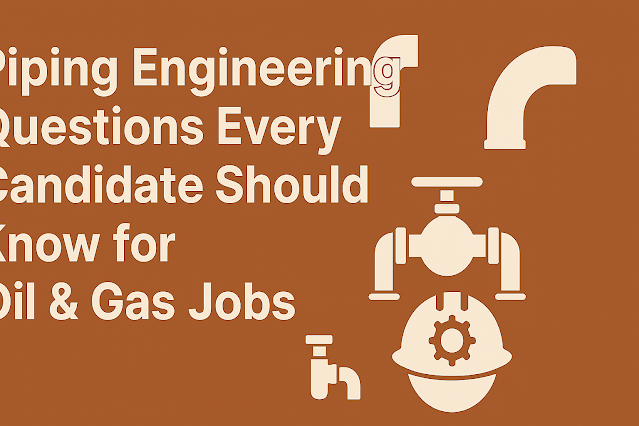🛠️ Piping Engineering Questions Every Candidate Should Know for Oil & Gas Jobs
Piping engineers are essential to the safe and efficient transport of fluids across oil refineries, offshore platforms, and petrochemical plants. Interviewers often test both your technical knowledge and practical field experience.
Here are some must-know piping engineering questions to prepare for oil and gas interviews:
🔧 Fundamentals & Pipe Design
1. What are the common types of piping used in oil & gas?
Answer:
-
Carbon Steel (CS) – general process lines
-
Stainless Steel (SS) – corrosive services
-
Alloy Steel – high temperature
-
GRE/HDPE – seawater or buried systems
2. What is the ASME B31.3 code?
Answer:
It’s the code for Process Piping, covering materials, design, fabrication, testing, and inspection for chemical plants and refineries.
3. What is pipe schedule?
Answer:
Defines wall thickness. Higher schedule = thicker wall. Affects pressure rating.
4. What’s the difference between seamless and welded pipes?
Answer:
-
Seamless: Higher strength, no weld line
-
Welded: More economical, has a longitudinal weld
5. What is piping isometric drawing?
Answer:
3D-like drawing showing pipe routing, dimensions, fittings, elevations, and welds. Used for fabrication and installation.
🔧 Fittings, Supports & Stress
6. What types of pipe fittings are commonly used?
Answer:
Elbows, tees, reducers, flanges, valves, couplings, unions – based on flow direction and service.
7. What is the role of pipe supports?
Answer:
To control stresses, maintain alignment, and prevent sagging or vibration. Includes hangers, guides, anchors, and shoes.
8. What is thermal expansion and how is it managed?
Answer:
Pipes expand with temperature. Managed by:
-
Expansion loops
-
Bellows (expansion joints)
-
Proper support spacing
9. How is pipe stress analysis performed?
Answer:
Using Caesar II or similar tools, considering loads:
-
Sustained (weight, pressure)
-
Thermal
-
Occasional (seismic, wind)
10. What are the causes of pipe vibration?
Answer:
-
Flow-induced turbulence
-
Pump/compressor pulses
-
Loose supports
Solution: Proper clamping, bracing, damping.
🔧 Valves, Ratings & Materials
11. What types of valves are used in piping systems?
Answer:
-
Gate – isolation
-
Globe – throttling
-
Ball – quick shut-off
-
Check – prevent backflow
-
Control – modulating flow
12. What is PN and Class rating for flanges?
Answer:
Pressure ratings:
-
PN (metric) – PN10, PN16, PN40
-
Class (ASME) – 150, 300, 600, etc.
13. What is the difference between NPS and DN?
Answer:
-
NPS (Nominal Pipe Size): Inches-based (e.g. NPS 4)
-
DN (Diameter Nominal): Metric-based (e.g. DN 100 ≈ NPS 4)
14. Why is material traceability important?
Answer:
Ensures materials meet specs and codes. Required for QA/QC, safety, and regulatory compliance.
15. What are common piping material specifications?
Answer:
-
ASTM A106 (CS seamless)
-
ASTM A312 (SS)
-
ASTM A234 (fittings)
-
ASTM A105 (flanges)
🔧 Construction, QA/QC & Safety
16. What are hydrostatic and pneumatic tests?
Answer:
-
Hydro: Uses water to test strength/leak
-
Pneumatic: Uses air or gas – more dangerous but used when water is unsuitable
17. What documents are critical during installation?
Answer:
-
Isometric drawings
-
P&IDs
-
Weld maps
-
Material Test Certificates
-
Pressure test reports
18. What is flange facing and why is it important?
Answer:
The finish on flange face (e.g., RF, FF, RTJ) affects sealing performance with gaskets.
19. What safety measures apply in piping work?
Answer:
-
Hot work permits
-
Pressure test barricading
-
Lockout/tagout for valves
-
Confined space entry
20. What is spool fabrication?
Answer:
Piping sections prefabricated in a workshop (with welds and fittings) then assembled at site to improve quality and reduce fieldwork.




No comments:
Post a Comment